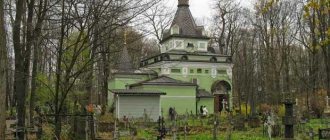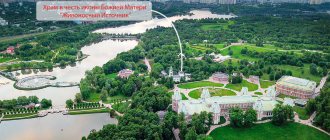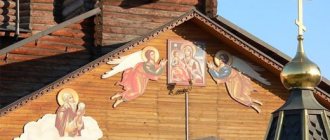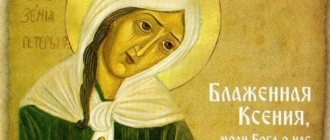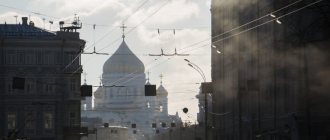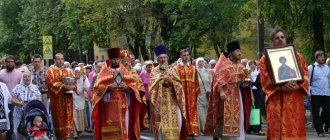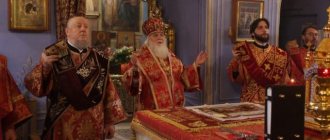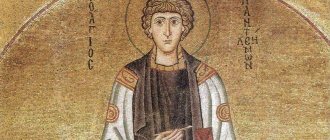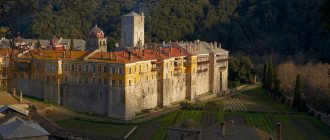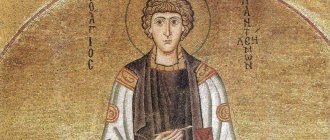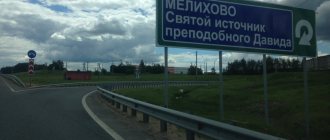Among the beautiful and interesting corners of the Krasnodar Territory, the small resort town of Goryachiy Klyuch occupies a worthy position. This is because here, in addition to picturesque landscapes and numerous attractions, there are balneotherapy clinics and natural springs. One of the visited points is the chapel of the Iveron Icon of the Mother of God located in the rock with the healing water of the Panteleimonovsky spring.
History of the shrine
Goryachy Klyuch is the oldest hydrotherapy resort town in the Krasnodar Territory. It was founded in 1864, and before that there was a settlement of the Circassians Psyfabe here. Its name was dedicated to the hot liquid baths located here (the temperature of some is up to +60 degrees). People who lived in the surrounding area noticed that drinking “live” water healed many diseases. During the Caucasian War, in 1860, there was a mass deportation of the Circassians and other peoples of the Caucasus to the Ottoman Empire.
The history of the chapel dates back to the second half of the 19th century, when in 1864 a military hospital with a bathhouse was built in the town. Over time, the fonts began to be consecrated - first coming out at the foot of the Abadzekh Mountain, which are called Psekupsky, and then located near the entrance to the Danto Gorge. Here, where the springs of healing water flowed, a small temple-chapel was built, dedicated to the image of the Iveron Mother of God. They were visited by townspeople and visitors, because the “life-giving” properties of the local waters are known far beyond the borders of this region of Kuban.
At the beginning of the 20th century, a shift in mountain layers occurred near the chapel, which led to a sad event - the liquid disappeared here. The path to the famous place began to overgrow. Where the “living” water flowed out, only a stone grotto remained. The Iverskaya Chapel in Goryachiy Klyuch began to receive visitors when the spring located next to it in honor of St. Panteleimon was restored. In 1995, it was consecrated, and in 2011, the head of the municipal city, Nikolai Iskhilevich Shvartsman, took the initiative to improve this entire territory.
Chapel of St. Panteleimon in old Moscow
| Epiphany Monastery on Nikolskaya Street. It housed the chapel of the Great Martyr. Panteleimon. Photo from 1883. |
In old Moscow, several hospital churches and the famous chapel in Kitai-Gorod on Nikolskaya Street, which stood opposite the Church of the Vladimir Icon of the Mother of God, were consecrated in the name of the Holy Great Martyr Panteleimon.
It was also destroyed by the Bolsheviks. The Holy Great Martyr Panteleimon lived at the end of the 3rd - beginning of the 4th centuries. from the Nativity of Christ. He was born in the Asia Minor city of Bethany, into a rich and noble family: the baby was named Pantoleon, which meant “a lion throughout.” His father was a pagan, and his mother, Saint Evvula, was a Christian and raised her son in the true faith, but died early. The father sent the boy to a pagan school, and then sent him to Nicomedia to study the art of medicine. In this city, Saint Panteleimon was to accept the crown of martyrdom for Christ. Soon after completing his studies, the talented young man was introduced to the pagan emperor Maximian, who wanted him to remain as a court physician. At the same time, Saint Panteleimon secretly met Presbyter Ermolai, and every evening listening to his word about Christ, he himself believed. One day, returning home after a conversation, he saw a dead child on the road, who had died from the bite of an echidna, which was writhing nearby. Saint Panteleimon began to ask the Lord to resurrect his child and kill the viper, deciding that if his prayer was fulfilled, he himself would become a Christian. His request was fulfilled before his eyes, and he received Holy Baptism from Presbyter Ermolai. And then, after conversations with his son who believed, Saint Panteleimon’s father also converted to Christianity.
Having become a Christian, Saint Panteleimon continued to heal the sick, combining prayer with the gift of medical art. Through prayer to the Lord, he healed the suffering, the poor, the poor, and prisoners free of charge. Out of envy, other doctors reported to the emperor that Saint Panteleimon was a Christian and was treating Christians - it was a time of terrible pagan persecution. Maximian demanded that the saint make a pagan sacrifice, but instead he saw with his own eyes how Saint Panteleimon, through prayer, healed a paralytic. The wicked ruler, in a rage, ordered the healed man to be executed and Saint Panteleimon to be tortured. The martyr asked the Lord to strengthen him and heard an encouraging voice: “Do not be afraid, I am with you!” Having failed to achieve renunciation, the emperor ordered the death of Saint Panteleimon, but the sword suddenly became soft as wax, and the amazed soldiers exclaimed: “Great is the Christian God!” At this time, the Lord again revealed himself to the martyr and his executioners: a voice from heaven publicly called him “Panteleimon,” which means “much merciful.” Thus, shortly before his death, the martyr Pantoleon was given a new, true Christian name.
The soldiers refused to execute the saint, but he himself ordered them to carry out the order of the emperor - death befell him in 305. When his head was cut off, the blood sprinkled the olive tree, which blossomed and bore healing fruits. The saint's body was thrown into the fire, but turned out to be undamaged, and he was buried in Nicomedia.
The first churches in the name of St. Panteleimon appeared already in the 4th century in Constantinople and Sebastia of Armenia. In Rus', the great martyr was revered already in the 12th century. Grand Duke Izyaslav accepted Christian baptism under the name of Panteleimon and wore the image of the saint on his helmet - this once saved his life in battle. Under Peter I, on the feast of the Holy Great Martyr, the Russian army twice won victories in the Northern War - at Gangut in 1714, which was the first victory of the Russian fleet over the Swedes, and at Grengam in 1720. Two years later, the emperor ordered the construction of a temple in the name of St. Panteleimon in St. Petersburg.
Nowadays the honorable head of the saint rests in the Russian St. Panteleimon Monastery on Mount Athos, and his courtyard is open in the Nikitsky Church in Kotelniki near Taganka. Not long ago, the venerable relics of Saint Panteleimon were brought to Moscow and exhibited for veneration in the Novospassky Monastery for several days. In the Orthodox Church, Saint Panteleimon is called upon to help with the Sacrament of Anointing.
The foundation of the Moscow chapel was due to the fact that in 1866 the icon of the Mother of God “Quick to Hear” and with it other shrines were brought to Moscow from the Russian Panteleimon Monastery on Athos: particles of the holy relics of the healer Panteleimon, a holy cross with a particle of the Life-Giving Tree, part of the Tomb stone The Lord's. Hieromonk Arseny, who brought them to Moscow, stopped upon arrival at the Epiphany Monastery for men, and in its cathedral church the shrines were displayed for veneration. A great crowd of people gathered who wanted to venerate them, so that the temple was filled with people praying from morning to evening: healings were performed and performed, the good news about them spread around the city, and more and more people came.
Due to the huge number of pilgrims, in 1873 at the Epiphany Monastery, with the blessing of the Athonite elders, they built the Athonite Chapel for these shrines, on the same Nikolskaya Street. (Now in its place is a corner square at the intersection of Nikolskaya and Bogoyavlensky Proezd, since the building was demolished in 1929.) However, over time, the small chapel became cramped for everyone who wanted to venerate the shrines. Already in 1879 they began to think about building a new one.
And in 1880, the brother of the rector of the Athonite Panteleimon Monastery, hereditary honorary citizen Ivan Sushkin, donated a plot of his land for her to the monastery on Nikolskaya Street closer to the Vladimir Gate. A year later, construction began on a new chapel in the name of St. Panteleimon, with numerous donations from Muscovites. It was erected by the famous architect A. Kaminsky, son-in-law of the Tretyakov brothers, author of the neighboring Tretyakovsky Proezd arch. To commemorate the continuation of the tradition, he originally reproduced on the facade of his building the appearance of the facade of the old Athos Chapel.
The structure turned out to be very unusual for Moscow, since the chapel from the outside looked like a huge, majestic temple, of great height and impressive size. Now she could accommodate the multitude of worshipers who flocked to her and crowded in line at the chapel all day. There was another, purely architectural decision of the architect to create a new high-rise dominant on Nikolskaya Street, formed by a church building: in continuation of the historical tradition of building this area, where the bell towers and churches of the Epiphany, Zaikonospassky and Nikolsky monasteries rose. Now the new grandiose chapel dominated not only Nikolskaya alone, but also the entire Kitay-gorod, the largest business center of Moscow, in which tall “secular” buildings of commercial banks, insurance companies, and joint-stock companies were already being built.
In June 1883, the consecration of a new Moscow chapel, assigned to the Epiphany Monastery, took place, and Athos shrines were reverently transferred to it. It was considered one of the richest relics in Moscow: there was a miraculous image of the Savior, the icon of the Mother of God “Quick to Hear” and Iverskaya, the holy Great Martyr Panteleimon, the ark with holy relics.
The feast of St. Panteleimon was a Moscow celebration. Every year on July 27 (August 9), a procession of the cross departed from the chapel to the Epiphany Monastery. Nikolskaya was crowded with pilgrims, and so that all those praying could bow and venerate the miraculous icons, the images were taken out into the street on this day and placed under a special tent.
On ordinary days, Orthodox Muscovites went to the Panteleimon Chapel for blessed, healing lamp oil.
“For convict brands, For every illness, Baby Panteleimon, We have a healer,” -
Marina Tsvetaeva wrote about the chapel. They also went here for grace-filled spiritual help to the famous shepherd, rector of the chapel, Hieroschemamonk Aristoklius of Athos, who served here for many years. As a child, he himself suffered a serious illness - paralysis of his legs, until his mother vowed to enter a monastery if her son was healed. Having become the rector of the Panteleimon Chapel, he not only spiritually nurtured his flock, but also helped the poor financially, obtained funds for the education of children from poor families, married off brides, accepted donations, and immediately transferred them to the poor. According to the testimony of his spiritual daughter, he predicted the Great Patriotic War and the future salvation of Russia by the Grace of God. According to his foresight, Father Aristoclius was buried at the Danilovsky cemetery. And after the death of the shepherd, a miraculous sign was revealed: when the coffin was being taken to the churchyard, a huge flock of pigeons, which Father Aristocles loved very much, flew in, and, circling, the birds formed a living cross in the sky. So they accompanied the priest to the grave.
Pilgrims from all over Russia gathered at the Panteleimon Chapel. Those suffering from blindness, epilepsy, obsession, mental disorders, bodily infirmities and mutilations hoped to find healing here and found it. And after the revolution, the icon of St. Panteleimon exuded a special power of grace, as if affirming the true faith in godless times. In 1927, shortly before the closure of the chapel, a miraculous healing of a sick Jew, Grigory Kalmanovich, from cancer took place here, and this miracle led him to believe in Christ and accept Holy Baptism. The disease was already at that stage that the doctors considered treatment useless and determined his remaining life to be two weeks. On the way from the clinic, Kalmanovich drove past the chapel and suddenly experienced an incredible desire to go into it. His wife tried to dissuade him from saying that this was a Christian church, but he still went into the chapel. There was a prayer service going on there. The patient knelt down in front of the image of the healer and stood in tears throughout the service, and then reverently kissed the icon and experienced incredible relief - the pain was relieved and he felt healthy. When doctors examined him again, they found no traces of the disease. Without saying a word about his prayer, the healed man returned home and immediately went to the local church, where he told this story to the priest - and joyfully accepted the Christian faith.
| Church of the Resurrection in Sokolniki |
After the revolution, the authorities banned the miraculous image of St. Panteleimon from being taken out into the street on holidays.
The chapel was closed in 1932 and two years later was broken down along with the fortress wall of Kitai-Gorod, but the Grace of God preserved almost all of its shrines for Moscow. The miraculous image of the Savior is in the Church of Saints Florus and Laurus on Zatsepa (see August 31), the icon of the Mother of God “Quick to Hear” was transferred to the Church of Saint Nicholas the Wonderworker in Klenniki on Maroseyka, Iverskaya - to the Church of the Sign in Pereyaslavskaya Sloboda (near metro station "Rizhskaya" ). The miraculous image of the holy great martyr Panteleimon himself and the ark with holy relics from his chapel are now in the famous Church of the Resurrection in Sokolniki. So, fortunately, the priceless Moscow shrine was not lost. House hospital churches with altars in the name of the Great Martyr Panteleimon were located at the Bakhrushinsky hospital on Stromynka (now named after Ostroumov), in the Mariinsky shelter on Donskaya Street, set up for the care of elderly sick women of noble origin, and in the Medvednikovsky hospital behind the Serpukhov outpost.
All of them were closed after the revolution. Elena Lebedeva https://www.pravoslavie.ru/jurnal/168.htm
Overview of Panteleimon's spring, obelisk and chapel
Iveron Chapel
In 1999, the restored Iverskaya Chapel again opened the door to visitors, and again prayers of petition and thanksgiving to the Lord and Our Lady were heard here. From a distance, against the backdrop of the slopes, it looks like a toy - a small church in white and blue tones with a hipped roof and one onion dome. It’s like it’s sewn into a mountain spur. In the corners at the foot of the tent, crosses rise on pyramidal domes. There is an arch above the front door, where a small image of the Virgin Mary “greets” those entering.
In 2015, the face of the Mother of God “Iversky”, which is also popularly called the “Goalkeeper”, was placed inside the chapel - it was made by masters of Florentine mosaics in Krasnodar. The history of the image captures many cases of the gracious help of the Mother of God, including the healing of the sick. There is a candlestick next to it, so those who wish to do so put candles here. On Friday, a priest comes to the chapel and believers gather to read the akathist to the Mother of God “Iverskaya”. Water-blessing prayers are also performed here (the schedule for them is posted at the entrance).
Panteleimonovsky source
On the territory where the chapel is located, on the left side there is a source of the great martyr and healer Panteleimon. During the restoration, an arch of stone was laid over it, where they placed an icon of the saint, cast in bronze according to the design of the sculptor and Honored Artist of Russia - Vladimir Andreevich Zhdanov. The reconstruction work was carried out by the Krasnodar construction company under the leadership of Sergei Kutsov. Residents of Goryachiy Klyuch also helped in the good cause of restoring the local shrine.
Istok is popular not only among city residents, but also among visitors. Its ferruginous water prevents anemia, improves the functions of the digestive organs, restores metabolism, and when warm, stimulates the secretion of gastric juice. Well, don’t forget that the source of St. Panteleimon is first and foremost a spiritual place. Through prayers to this healer, miracles occur, including cases of healing from various diseases. After all, he was both a warrior and a doctor who received the special divine grace of the Holy Spirit.
The rector of the Holy Trinity Church in Goryachy Klyuch, Father Alexy (Spitsyn), comes here to perform water blessing prayers.
Obelisk
An obelisk was erected opposite the Iveron Chapel - this was back in pre-revolutionary times, in 1914. It was dedicated to the 50th anniversary of the development of the Psekup mineral baths, and also as a token of gratitude from many people who cured various diseases with the help of the sources of the Hot Spring. In 2007, after reconstruction, the monument acquired its original appearance; now a double-headed eagle rises on its top, and on the sides there are signs with the names of those who worked to create the resort.
This obelisk became a landmark of the resort city and the only monument in the world that was dedicated to life-giving waters.
Orthodox wedge
Author: Mikhail MolotnikovOn the road leading from Klin to Vysokovsk, the village of Pershutino is located. Its historical landmark today is the small beautiful chapel of the Great Martyr Panteleimon, located right next to the road. This brick plastered building on a white stone plinth was built in 1905. Its architecture contains features of the pseudo-Russian style, characteristic of many buildings at the turn of the 19th–20th centuries.
According to the stories of local residents, the chapel on the Volokolamsk tract in the village of Pershutino was erected back in 1861 in memory of the liberation of peasants from serfdom. Apparently, it was wooden and consecrated in honor of the holy noble prince Alexander Nevsky. In 1905, a stone chapel with an iconostasis was built on the same site.
During Soviet times, the building was converted into a kerosene shop. At the same time, the iconostasis was lost and the roof was changed.
In 1991, the chapel was returned to the believers and, at their request, consecrated in the name of the great martyr and healer Panteleimon. In 1998, through the efforts of philanthropists, it was thoroughly restored and decorated with icons, the most venerated of which is the image of the holy great martyr and healer Panteleimon.
On the day of celebration of his memory, August 9, the Divine Liturgy is celebrated in the chapel, and the day before - an all-night vigil. Every Friday at 6 o'clock in the evening a water prayer service is served with an akathist to the Great Martyr Panteleimon.
The chapel is assigned to the Transfiguration Church in the village. Selinskoe, whose rector is priest Vitaly Toroptsev.
Photo from the collection “Orthodox Klin”
Great Martyr and Healer Panteleimon Author: Mikhail Molotnikov Saint Panteleimon lived at the beginning of the 4th century, during the terrible persecution of Christians by Emperor Diocletian. He was a doctor. Having believed in Christ and accepted holy Baptism, he began to heal people with prayer to God. These healings were so amazing that many sick people rushed for his help.
Healer of souls and bodies Author: Irina Filippova On August 9, Orthodox Christians honor the memory of the holy great martyr and healer Panteleimon, to whom it is customary to turn for prayerful help in illnesses. Today, in every Orthodox church there is an icon of the healer Panteleimon, and the flow of sufferers near his image does not dry out. In the Klinsky district, there is a chapel of the healer Panteleimon in the village of Pershutino.
Reproduction on the Internet is permitted only if there is an active link to the ORTHODOX WEDGE website. Reproduction of site materials in printed publications (books, press) is permitted only if the source and author of the publication are indicated.
How to get there (get there)?
Getting here is not difficult at all. In this direction, to the “Goryachiy Klyuch” sanatorium stop, there are three minibuses at once - No. 1, No. 2 and No. 10, running through the entire regional center.
By car, it’s easy to get from the central part of the city to the shrine this way:
Note to tourists
- Address: Healing Park, Goryachiy Klyuch, Krasnodar region, Russia.
- GPS coordinates: 44.620725, 39.093742.
Goryachy Klyuch is a quiet, provincial town with picturesque nature and clean air. It gives rest to both body and soul. First of all, people come here to prevent various diseases with the help of healing mineral waters, and to recharge themselves with strength from nature. When visiting the Iverskaya Chapel and the Panteleimon Spring, one becomes familiar with the spiritual world. The atmosphere here is conducive to prayer and communication with God. There is peace and quiet here, disturbed only by the singing of birds. Visitors are in no hurry to leave here; they love to stroll along the well-groomed sidewalk paths and relax on benches in the shade of trees. The shrine has received numerous positive reviews and is included in many tourist tours and schedules of pilgrimage departments. One visit will be enough to fall in love with her.
